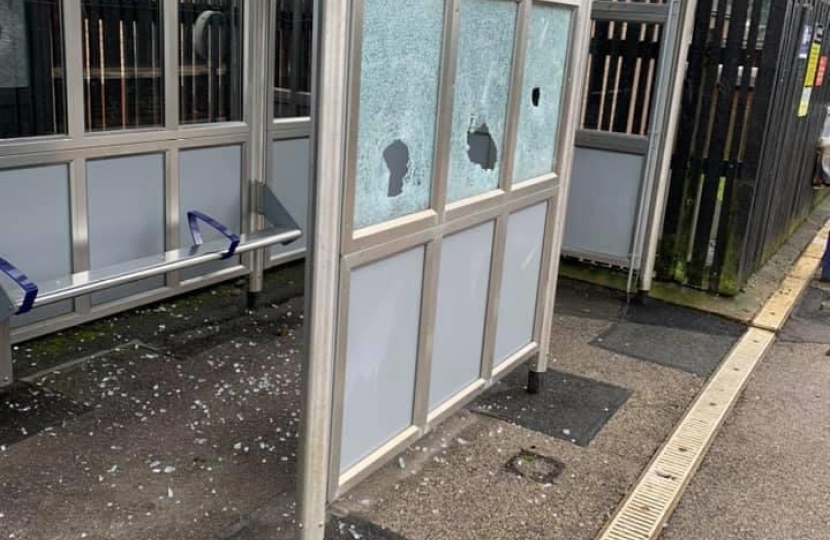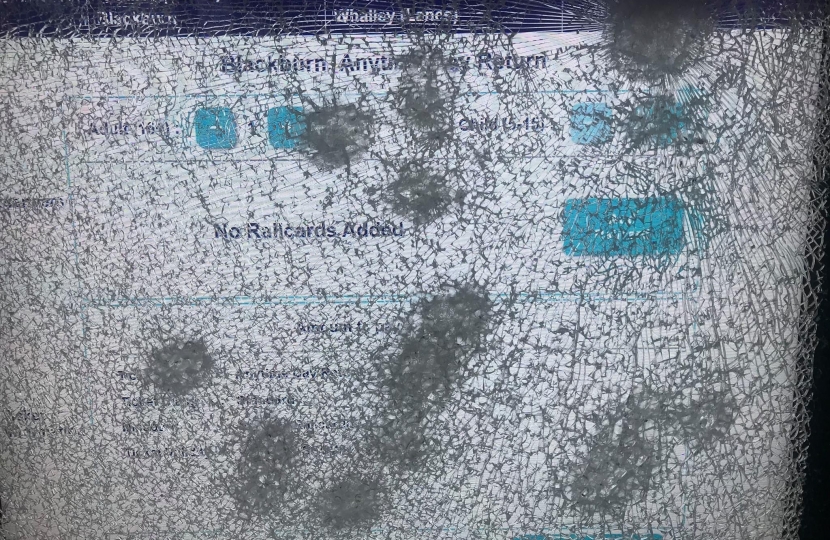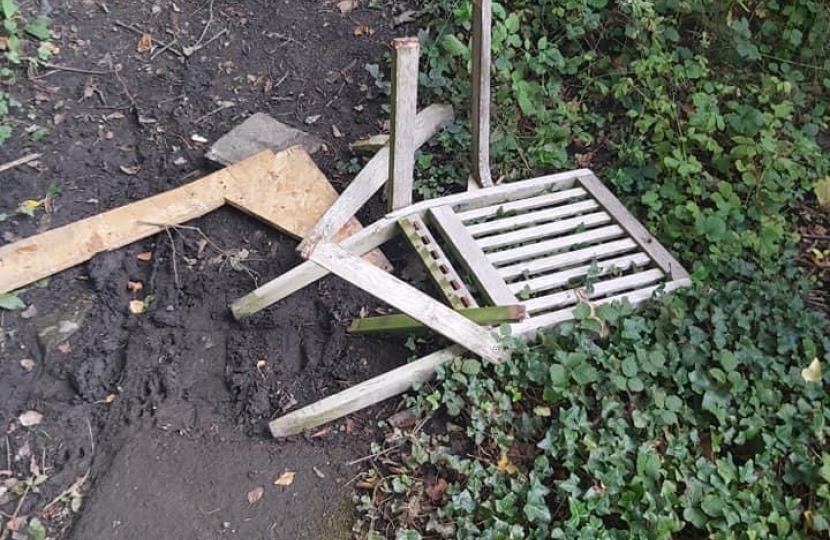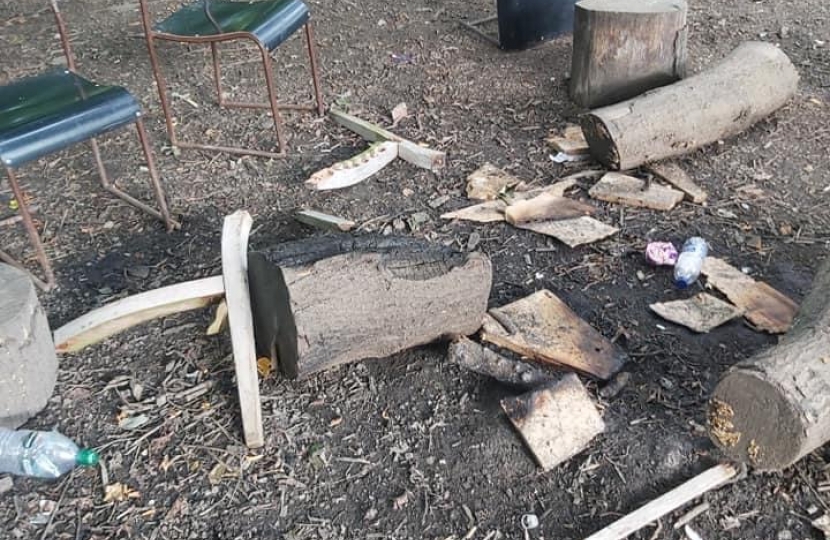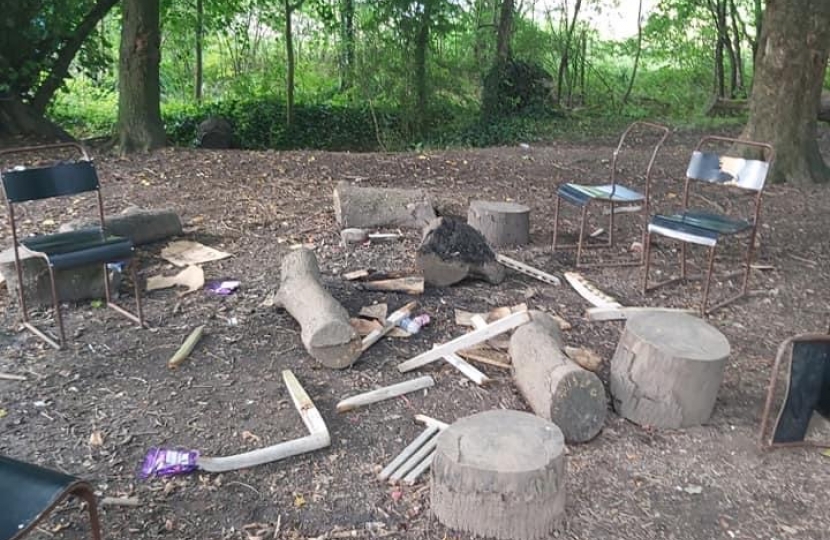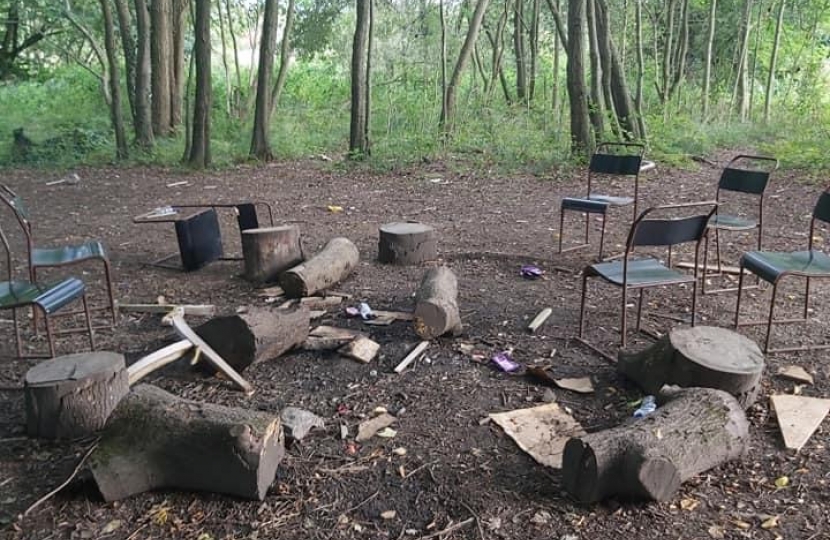Local Ribble Valley Borough Councillors, Mark Hindle and Ged Mirfin who represent Whalley and Painter Wood are calling for the introduction of a Zero Tolerance Policy towards Anti Social Behaviour in the Village. This follows a spate of serious vandalism in the village including the breaking-up chairs stolen from the cricket club which had been donated by members as well as the snapping of young oak saplings recently planted in the Forest Garden located behind the Bowling Club together with the smashing up of the Shelter on the Clitheroe platform and the ticket machine on the Blackburn platform on Whalley Train Station. It is estimated that the cost of the damage is in excess of £5,000.
Councillor Mirfin states, “What is required is visits to schools (someone must know who the culprits are and their peer group is a good place to start) as well as a raft of other zero tolerance measures to combat a rising tide of anti-social behaviour (ASB) in Whalley. The village is on a high state of Alert Elderly residents are living in a state of constant fear, literally wondering where the next incident is going to take place. This represents a very serious escalation in anti-social behaviour and requires a very serious escalation in response on the part of the authorities.”
Zero Tolerance refers to an approach to criminal justice is an approach that has been used in parts of the US and (to a lesser extent) the UK. he idea is that low-level crime should not be tolerated and severe penalties should be in place for anti-social behaviour and minor incivilities in order to deter more serious crime with the heaviest possible sentences being imposed on people for minor crimes and the discretion that police use their powers in a highly discriminatory manner targeting those who frequently engage in anti social behaviour.
This is known as the broken windows’ rationale. The ‘broken windows’ rationale for tackling ASB assumes that there is a causal link between disorder, or ASB, and crime. It is argued that disorder can provoke fear; and, further, that the fear can itself help to create the physical and social environment in which real crime will flourish. This is because residents who are fearful are likely to withdraw from public spaces, and will not intervene when they observe disorderly or criminal behaviour. Informal social controls over an area are thus relaxed; local troublemakers and offenders become bolder in their actions; and offenders from outside the area are attracted to it. The process by which disorder leads to fear and crime is symbolized by the broken window. It is argued that if a broken window in a building remains unrepaired, all the other windows in the building will soon also be broken, because ‘one unrepaired broken window is a signal that no one cares, and so breaking more windows costs nothing. (It has always been fun).’
The implications of broken windows theory for policing are clear. Visible foot patrols by police officers can play a critical role in halting or reversing the process by which disorder gradually gives rise to serious crime. Through patrols, the police can carry out the ‘order maintenance’ functions.
The key is to identify neighborhoods at the tipping point – where the public order is deteriorating but not unreclaimable, where the streets are used frequently but by apprehensive people, where a window is likely to be broken at any time, and must quickly be fixed if all are not to be shattered.
The ‘broken windows’ rationale Is an almost irrefutable justification – for a host of policing and crime prevention measures that target ASB. If a window is broken or a wall is covered in graffiti it can contribute to an environment in which crimes takes hold, particularly if intervention is not prompt and effective. Anti-social behaviour and crime go hand in hand and create a sense of helplessness that nothing can be done. Neighbourhoods in which lack of order and poor respect for the environment continue to prevail are very often those from where many active criminals will emerge and thrive. Orderliness will begin to bind a neighbourhood and build a resilience which makes crime less likely. Serious crime like dealing in Class A Drugs can take hold in a community following minor incidents of criminal damage and ASB. ASB can provoke fear of crime, which in turn keeps people away from an area and weakens natural surveillance. More worryingly many people – particularly children and young people – who engage in relatively minor ASB are likely to move on to more serious forms of misbehaviour, and ultimately criminal behaviour, in the absence that is of intervention. Young people must learn that their actions have consequences: if behaviour are not seen to have consequences, there will perpetrators engaging in increasingly serious misbehaviour. Certain young people are driven towards ASB and crime because they are looking for excitement. Therefore if misbehaviour goes unchecked, it is likely to escalate, since ‘getting away with it becomes the norm then and boring, and they move on and want to do more challenging crimes’.
The capacity of the police to take action against ASB has been extended through the introduction of fixed penalty notices for disorderly behaviour by the Criminal Justice and Police Act 2001 (the use of fixed penalty notices was then widened by the Anti- Social Behaviour Act 2003). At the same time, the creation of Police Community Support Officers (PCSOs) under the Police Reform Act 2002 widened the uniformed presence on the streets – with the explicit aim, among others, of contributing to enforcement against perpetrators of ASB, and deterring potential perpetrators.
Councillor Mirfin states, “I therefore call on the Police, in partnership with the local authority, to undertake to provide residents with information packs, contact numbers and advice on how to report Anti Social Behaviour. The escalation in incidences of Anti Social Behaviour now requires preventative measures put in place to help stop the issues arising in the future. We need to take long-term action, rather than just reacting when problems arise.
Councillor Mirfin continues, “This has all the appearance of the small gang of youths that terrorised Local Residents who live on the Sands, sticking two fingers up and saying if you think you’re hard enough come and get us. There is already talk in the village of vigilantism as tolerance levels run low. The danger is that the wrong people will end up being persecuted because they feel insufficient is being done to protect property. The authorities need to act now and act now before the problem gets any worse and someone gets hurt!”
Councillor Mirfin further continues, “What is required in the first instance is the appointment of an ASB Coordinator in the Village to spear head a drive to crackdown on a rise in complaints about behaviour. Police are already carrying out extra patrols targeting popular places where gangs of youths are congregating in a bid to encourage consideration for people living nearby but at the end of the day a Collar needs to be felt and prosecutions made so that the full force of the law can be applied. Until that happens we are unlikely to make the desired impact.”
The term anti-social behaviour covers a wide range of unacceptable activity that blights the lives of many people on a daily basis. ASB is defined as ‘behaviour by a person which causes or is likely to cause harassment, alarm or distress to one or more persons not of the same household as the person. The recent increase in Anti-Social Behaviour around the village is d ue to the lighter nights and young persons being out and about just that bit later.
Councillor Mark Hindle states, “I am pleased to see Ribble Valley Police and the British Transport Police working collaboratively to identify the people who caused criminal damage and a nuisance on the Whalley Train Station platform and the criminal damage done to pitch side furniture stolen from the cricket club in recent days. This kind of vandalism and anti-social behaviour is both unacceptable and is intimidating toward and worrying a large number of residents in the Whalley area.”
Councillor Hindle continues, “I firmly believe that the majority of particularly young people are law abiding and not involved in these kinds of anti-social behaviour and myself and my fellow Councillors call on the Ribble Valley Police to identify the people causing this criminal damage because that’s what it is: the young people committing the vandalism are committing a criminal offence - they are breaking the law and should be held to account and brought up before the courts, convicted and a sentence brought to bare. We should not be forced to tolerate such actions. If the authorities do not take action then the tennis, football, bowling and cricket clubs will certainly take action if they find out who the perpetrators are as will Network Rail.”
Councillor Hindle continues, “For those not committing offences I would strongly encourage their parents to chat with their children about their whereabouts and to start conversations about staying safe and discouraging nuisance behaviour among their friends. What would their parents say? Do they actually know where they are?”
Parents could:
• Ask children to be aware of their surroundings
• Ask them to be aware of the numbers in the group
• Ask where they are going and with whom
• Urge youngsters to consider if their parents or grandparents would approve of what they’re doing and if not, stop
• Urge them to leave the area if their mates are doing something they think is wrong
• Encourage them to be respectful and mindful to other people
Councillor Mirfin concludes, “Something serious needs to happen. New powers to tackle anti-social behaviour that were introduced through the Anti-social Behaviour, Crime and Policing Act 2014.
One such power is what is known as the formal Anti-social Behaviour Case Review, commonly known as the Community Trigger. This is an important safety net in ensuring that victims’ voices are heard. This Community Remedy also gives victims a say in out-of-court punishments where the perpetrators of anti-social behaviour are dealt with through what is known as a community resolution disposal. This was designed to ensure that local agencies have the tools they need to respond to different forms of anti-social behaviour. Such as Public Space Protection Orders and Dispersal Orders. I don’t think we are there yet in terms of these two provisions but I call on the Lancashire Police and Crime Commissioner to authorise the use of a Community Trigger to put in place a plan of action to combat the growing anti-social behaviour in Whalley which can be published and put before the public in the village. It is no less than they deserve.”
Councillor Mirfin continues, “The ASB Case Review, or ‘Community Trigger’, is an important statutory safety net for victims of anti-social behaviour who believe they have not had a satisfactory response to their complaints about anti-social behaviour. Where a locally determined threshold is met, victims can require the relevant bodies in the local area to undertake a formal review of the case, and those bodies have a statutory duty to undertake that review.”
The ‘Community Trigger’ is an important safety net for victims of persistent anti-social behaviour. It provides a mechanism to ensure that their case is reviewed in order to secure a satisfactory resolution. The legislation requires the relevant local agencies to determine a local threshold for triggering the Case Review procedures. It is important that these agencies ensure that victims are aware of the procedures, the circumstances in which they can apply for a formal review, and how to do so. Consideration should also be given on how victims can best express the impact that the anti-social behaviour has had on their lives.
The relevant bodies in any area are those organisations listed below who must have an ASB Case Review/Community Trigger procedure in place and who must undertake a case review when a person asks for one and the local threshold is met. The relevant bodies are:
• the district council, unitary authority or relevant London borough council for the area;
• the police force covering the area;
• the relevant clinical commissioning group in England or local health board in Wales; and • local providers of social housing who are co-opted into the local arrangements.
Councillor Mirfin concludes, “Ultimately we are seeking to levy Referral Orders against the perpetrators of anti-social Behaviour.”
A Referral Order is a legal contract imposed by the courts which is designed to discourage a young person from further offending. A young persistent offender who merits a higher sentence can now be placed on an Intensive Supervision and Surveillance Programme (ISSP): this intensive intervention is intended to improve community-based alternatives to custody and to keep persistent young offenders in their homes or in school.
Youth Courts have a range of sentences available to them. These are designed to prevent further offending and include the making of a Detention and Training Order of up to two years.
The last word goes to Councillor Mirfin. He concludes, “Where are the parents? They have no control and they don’t care a bit about what their children are doing and where they are. We face a really challenging situation and we are doing all we can. We want the police to pursue a zero tolerance approach.It’s not that these kids have no where to go because they are actually intimidating younger children who are involved in clubs or sports and trying to ruin it for them as well. I strongly urge local residents who spot anti-social behaviour to report it to police. People need to make sure that they do report instances of anti-social behaviour in Whalley. People think nothing will happen with that information but believe me Lancashire Police are using it and will continue to use information reported by the general public in order to get an arrest and secure a prosecution. Evidence is crucial. This needs to stop but we have the power in our own hands to make this happen.”

